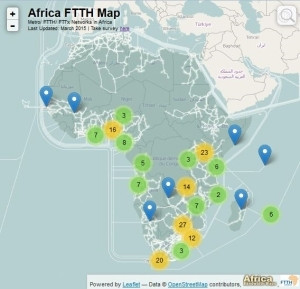Africa's inventory of terrestrial transmission networks has more than doubled in the last five years. According to the latest research by Africa Bandwidth Maps, Africa's total inventory of transmission network edges towards 1 million route kilometres; the continent had a total of 586 707km of operational fibre-optic network by December 2014. This comprises long-haul, metropolitan and FTTH/B (fibre-to-the-home/building) terrestrial fibre-optic networks.
Of this inventory of 586 707km of operational terrestrial fibre, at least 91 182km was within cities: metropolitan fibre rings and FTTH/B networks. The metro rings distribute bandwidth from fibre-optic nodes to districts and suburbs around each city. The FTTH/B networks provide the last-mile access, delivering bandwidth right to the door.
Terrestrial fibre reaches 44% of Africa's population
This network expansion has brought dozens of new towns, cities and countries within reach of high capacity national and international fibre backbone networks for the first time. Over the last five years, more than 150 million more Africans live within reach of fibre networks.
By June 2014, 44% of the population of sub-Saharan Africa (410 million) lived within a 25km range of an operational fibre-optic network node. This, compared to 41.8% of the population (371 million) in 2013, 40% (345 million) in 2012, 36.3% (313 million) in 2011, and 30.8% (259 million) in 2010.
The number of people within reach of a broadband service provided by fibre depends on the range of the fixed or wireless broadband access network used from the fibre node. In December 2014, 65.1% of the population (606 million people) lived within a 50km range of an operational fibre-optic network node. This distance of 50km is the maximum theoretical range of a WiMax network. Forty-four percent of the population (410 million) lived within a 25km range, and 22.3% of the population (207 million) lived within a 10km range of an operational fibre network node.
The new measurements now are how many people are within a zero kilometre reach of a fibre backbone. How many homes, public and commercial buildings are plugged directly into the fibre-optic backbone?
FTTH Council Africa survey
The FTTH Council Africa, in partnership with Africa Bandwidth Maps, announces its intention to conduct annual research to track FTTH/B penetration. Measuring penetration is critical to understand how the industry is progressing. The research will take place in the form of a short survey and will attempt to document as many metro and FTTH/B networks as possible.
The aim is to determine network reach and ultimately understand how many homes, public and commercial buildings are connected and the rate at which this is growing. If the council knows this, it will better understand what still needs to be done. The FTTH Council Africa would like to see all African operators participate to ensure technical accuracy of the data. The results will, over time, also establish trends and this information is important for the industry.
The survey is now open for network operators to add your network locations on to the map, and to update details on the progress of your FTTH roll-out.
The results for Q1 2015 will be compiled in April 2015. To make sure that your network information is included, and to receive a summary of findings, please complete the survey by 31 March 2015.
To complete the short survey, please click here:
https://www.surveymonkey.com/s/africa_ftth_survey.
The information gathered in this research will be used to compile statistical indicators of FTTH/B penetration in Africa, and to keep the map of metro/ FTTH/ FTTB networks as up-to-date and accurate as possible.
The FTTH fibre map displays the metropolitan, FTTH and FTTB networks which are currently operational. To date, the map contains 191 cities, towns and suburbs served by a total of 76 network operators, providing metro/ FTTH/ FTTx services in sub-Saharan Africa. Use the map to click on a city or suburb to find more information on the network operators providing services, in many cases with operators providing their own interactive coverage maps, coverage checkers, and/or a form to register interest to receive the service.
http://www.ftthcouncilafrica.com/index.php/fibre-map
http://www.africabandwidthmaps.com/ftth/

Share